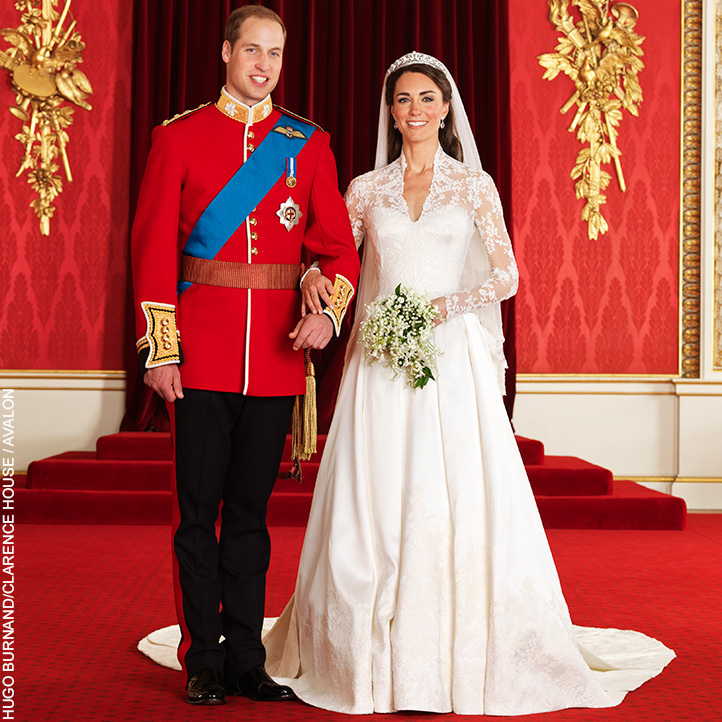It’s been 14 years since Kate Middleton debuted her stunning wedding dress.
Despite the big event taking place over a decade ago, the fascination with Kate’s bridal gown doesn’t look like it will die down anytime soon.

At the height of its popularity, brides-to-be would flock to boutiques with pictures of Kate in hand and ask designers to create versions of the elegant dress for their own special days. Some were merely inspired by aspects of the gown while others wanted more literal interpretations.
Although interest in the dress peaked in 2011 during The Royal Wedding, Google data shows us there’s been pretty consistent demand since—plenty of brides still use the search engine to pull up pictures of the gown regularly.

Getting married soon? Just love Kate’s wedding style and want to reminisce? On this page, you’ll find everything you need to know about the iconic dress. See video of Kate walking down the aisle, images of the now-Princess getting married and read about the craftsmanship that went into her gown.
First things first, a refresher:
Who designed Kate Middleton’s wedding gown?
Kate commissioned Sarah Burton to create her wedding gown. At the time, Burton was the Creative Director for luxury British fashion brand Alexander McQueen.

Vogue called the collaboration between Kate and Sarah Burton “the best-guarded secret in fashion history”.
The incredibly moving moment when the new Duchess of Cambridge stepped out of her car in an Alexander McQueen dress was the fantasy everyone in fashion has been dreaming would come true.
VOGUE
Kate continued to wear McQueen for all high-profile Royal engagements over the decade. I joke that she must have had Sarah Burton on speed dial!
Why did Kate Middleton choose Alexander McQueen?
According to official statements, Kate chose Alexander McQueen for the “beauty of [the company’s] craftsmanship, its respect for traditional workmanship and the technical construction of clothing.”

Kate wanted to infuse both tradition and modernity into the dress, but she also wanted Sarah Burton’s unique artistic vision to shine through. The final design resulted from a close collaboration between Kate and Burton, where Kate contributed design ideas and Burton applied her extensive fashion expertise.
What made Kate’s gown so special?
The simplicity and elegance of the gown. It had a sort of classic and universal appeal—a gown that everybody loved no matter their age. A gown that would transcend decades and wouldn’t feel dated in years to come. It was sleek and effortless but dreamy and romantic at the same time.

At the time, wedding dress designer Philippa Leply called the dress “almost Gracy Kelly-esque.” Karl Lagerfield of Chanel felt the classical charm of the dress went very well with the Westminster decor. He said the dress reminded him of “(Queen) Elizabeth’s wedding, the royal weddings in the (19)50s.”
The craftmanship behind the gown:
Sarah Burton had her team craft the the dress from ivory and white gazar fabric. French Chantilly lace and English Cluny lace were used for the handworked appliqué detailing that featured all over the bodice and box-pleated skirt. The appliqué work consisted of rose, thistle, daffodil, and shamrock design elements—symbolic of the four countries that make up Great Britain. (English Rose, Scottish Thistle, Welsh Daffodil and Irish Shamrock.)

The V-neck-lined bodice and long sleeves were nods to McQueen’s fascination for Victorian corsetry. The bodice narrowed down at the waist and was minimally padded at the hips to create a clean, flowy silhouette. The skirt was designed to look a like a flower opening up and led to a train that was 9 feet in length at the back.
Aside from the lace, all the fabrics used were British in origin. And indeed, Kate’s dress represents the finest of British craftsmanship. Much of the laborious work on the dress was wrought by talent sourced from all across the United Kingdom, including the Royal School of Needlework.

Timeless traditions woven in:
Kate incorporated the something old, borrowed, and blue tradition into her bridal attire. The “old” was the lace appliqué work carried out in the Irish Carrickmacross needlework tradition. A blue ribbon was sewn into the dress.

The “borrowed” was represented by the Cartier ‘halo’ tiara lent to Kate by the Queen. It held the bridal veil in place.
How much did Kate Middleton’s wedding gown cost?
Kate’s parents, Michael and Carole Middleton, reportedly paid £250,000 for the dress. Still, an unnamed official from Clarence House (which housed William’s press office at the time) would go on to dismiss these numbers.

ABC News said in 2011 that it was common practice for designers to be sworn to secrecy in matters of royalty
About Sarah Burton and Alexander McQueen:
Award-winning fashion designer Lee Alexander McQueen was known as the “enfant terrible” of the British fashion industry. His designs were edgy, original, and at times shocking, but noted for their impeccable tailoring and silhouettes.
He was also an ardent fan of blending traditional and modern influences. “You’ve got to know the rules to break them. That’s what I’m here for, to demolish the rules but to keep the tradition,” he said.
But Sarah Burton did take some of that edge off when she took hold of the reins at McQueen, following McQueen’s suicide in 2010. She added a touch of femininity and whimsy to the brand, giving it a softer, more universal appeal.
Burton initially signed up with McQueen as a personal assistant. She would become Head of Womenswear 3 years later.
In 2023, Sarah Burton left Alexander McQueen after two decades. It was announced in September 2024 that Burton would become Creative Director for French fashion house Givenchy.
